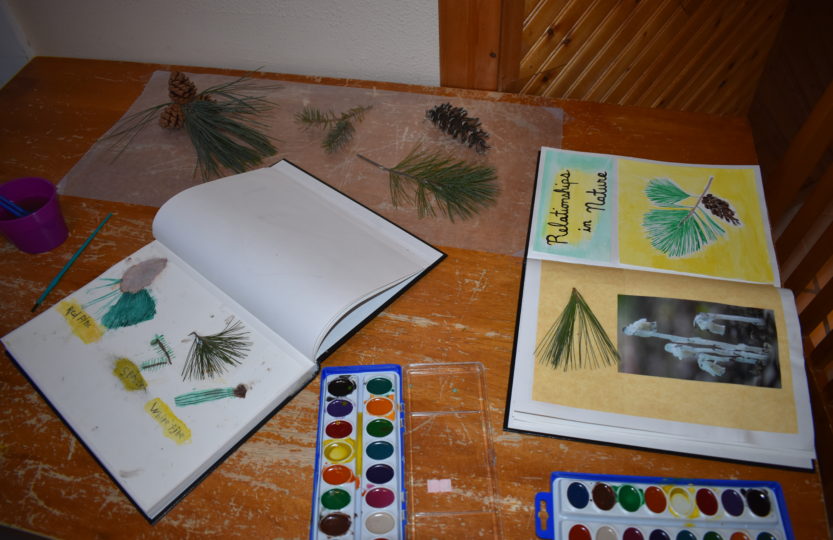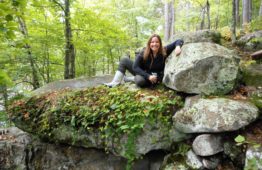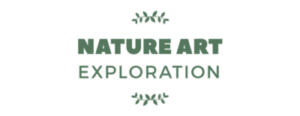Last month, I had the wonderful opportunity to take an educators’ course on Nature Journaling. It widened my perspectives on how to incorporate nature journaling into child education and re-lit my passion for journaling in nature. We explored methods of nature journaling aimed at building and strengthening relationships with nature, cultivating skills of natural observation, and facilitating scientific thought. It inspired me towards thinking of more ways to incorporate nature journaling into my family’s everyday life.
Nature journaling can really be an excellent way to get kids outside following their natural curiosities and connecting with the natural world. It strengthens their observation skills and gives them the opportunity to see science in action. It can also encourage them to pose questions about what they are observing leading to further investigation through additional observation and/or research. It’s a great way to help your kids and yourself slow down and tune in to listening to nature!
The main thing about nature journaling is that there is no wrong way to do it. Getting outside, connecting with the land, and writing down and/or drawing what you feel called to is a great way to start off. You could also have more of a predetermined goal to nature journaling if you so desire. For example, you and your child could decide to journal on the leaves budding in the spring, track the development of tadpoles over the period of a few months, or focus on the flowers blooming during various growth periods. The options are really endless.
You could also decide if you are going to journal on sounds you hear, sights you see, or the smells you encounter. Sensory journaling is a great way to help children isolate their experiences and tune in to specific sensory details. What you spend time journaling on is really up to you. There are NO RULES. Some people like to use a mixture of art and writing and often date their entries. Journaling alongside your child may encourage the practice and give you both the opportunity to bond in nature together. I find that working side-by-side with my child inspires us both. We feed off of each other’s curiosities and tend to go off on additional research tangents inspired by our observations and journaling time.
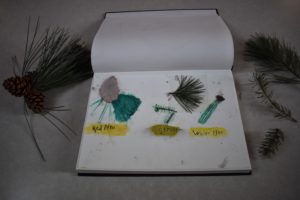
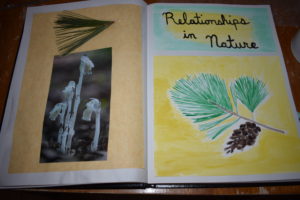
Above are pictures from our nature journaling fun from this week. For this journaling session, we roamed freely around our yard prior to selecting a place to observe. Sometimes, nature just has a way of attracting you to a specific place to focus on. Other times, you may head to a preselected area for a specific purpose. This journaling session was inspired at a location in our yard where White Pines hover over creating the most wonderful shade on sunny days. We were drawn to observing the White Pines and the environment below and around these trees. We were enthralled by the dried up stalks of Indian Pipe, Monotropa uniflora, which bloom prolifically there in the summer time. We sat pondering on the relationships between the trees and this most intriguing flower. This observation time inspired fantastic further research after our inside journaling time.
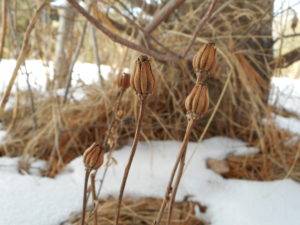
A member of the Heath family, Ericaceae, Indian Pipe is entirely white during its growth period. It lacks chlorophyll, the pigment that makes most plants green. It is really fascinating, because the flower is actually parasitic and gets its energy from a fungi that has a mycorrhizal relationship with the tree roots. This is exactly what we were thinking through our observation time. The fungi have a symbiotic (mutually beneficial) relationship with the tree roots. The trees are helped by the fungi through efficient absorption of water, phosphorus, and other nutrients. The fungi in return gets energy (carbohydrates) from the trees. Indian Pipe is parasitic on the mycorrhizal fungi. Photo Biologist has great pictures and additional information to check out on Indian Pipe.
After being absorbed by this fascinating environment of the White Pines and dried up Indian Pipe, we moved on to collecting a few pine needles and cones from trees in our yard and returned inside to do our journaling. During the winter, we do our nature journaling inside after time spent in nature taking a few pictures or materials that are OK to bring in. In the summer, we usually bring our nature journals with us, but really, you can do it either way. Just remember that some of the details or moments of inspiration may be lost if you wait too long to journal.
Finding what media your child is drawn to for journaling can really inspire your little naturalist. Watercolor is a favorite around here, so we have been incorporating the use of it in our nature journaling sessions. For now, I’m cutting down watercolor paper to paint and glue into our journals. A future investment for us is going to be a good Moleskine watercolor journal. It’s good to think about using a journal that has paper which will support the type of media you plan to use. Here’s a list of materials that are good to have on hand for nature journaling. Not all of these materials are essential. Start with the basics of a good journal and your media choice. This post contains affiliate links. Thank you for choosing to support Nature Art Exploration by shopping through the below underlined product links!
Materials for Nature Journaling
- Journal
or blank composition book (You could also make a simple journal with items you may have on hand)
- Moleskine watercolor journal
if you wish to use watercolor regularly (Watercolor paper, scissors, and glue sticks instead if you’d rather just attach occasional paintings to your journal)
- Watercolor kit
- Pencils (Graphite and/or colored
)
- Crayons
- Markers
- Ruler to measure your observations
- Magnifying glass
- Portable microscope
- Binoculars
- Hiking pack
- Water bottle
- Field guides (Flowers, trees
, wild berries/fruits
, mushrooms
, animals, animal tracks
, birds, insects, reptiles/amphibians, and stars/constellations
) The field guide links here are mostly for the Midwest United States. Make sure that the guides you purchase cover the area you live.
- Books to inspire nature journaling
Once you have the basic materials gathered that you plan to use, get out there and have fun. Remember that there is no wrong way to nature journal! If you’re the type of person who likes to get inspired by checking out others’ ideas, check out these Pinterest Nature Journaling Ideas.
Thank you for exploring nature journaling at Nature Art Exploration! Please, don’t forget to subscribe via e-mail, follow us on the social media links listed here, and check out our shop. As always, it’s great to hear from you. Please, feel free to share your nature journaling experience, ideas, or other comments below.
